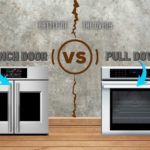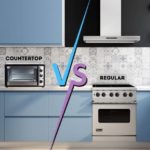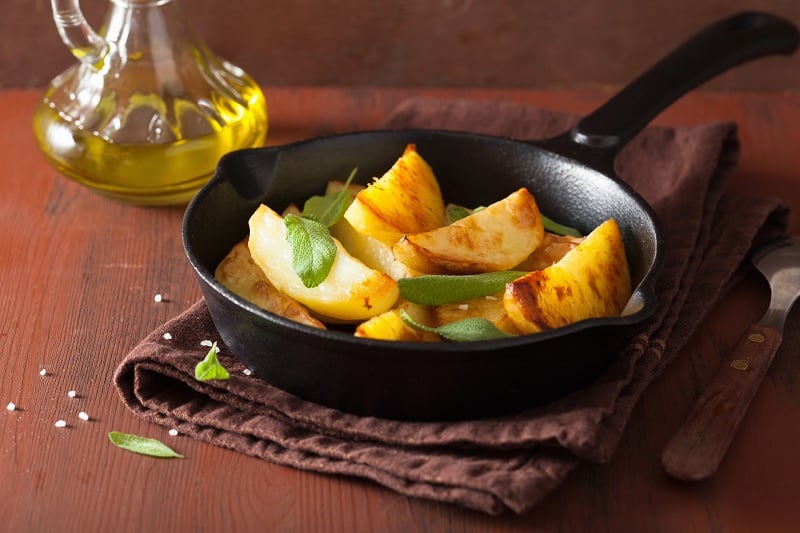You’ve heard of a toaster and an oven, but what is a toaster oven? Toaster ovens are essentially mini countertop ovens.
They typically have a door that pulls down to open, like a traditional oven, and one or two racks inside to hold whatever items you’re cooking.
If you’re considering buying a toaster oven, you’re in the right place. Here, we tell you all you need to know about these handy kitchen appliances—what they’re used for, how they compare to traditional ovens, and their disadvantages. Is a toaster oven a smart choice for your kitchen? Let’s find out.
What Can You Use a Toaster Oven For?
Much like a traditional toaster, toaster ovens are excellent for toasting slices of bread, bagels, and muffins.
Place your preferred bread product in the toaster oven and use the toasting function for a piece of bread that’s perfectly browned on both sides.
However, a toaster oven isn’t only for toasting bread! They are versatile kitchen appliances that can be used for various cooking tasks that are usually done in the oven. These include:
- Baking: You can use a toaster oven to bake cookies, brownies, muffins, small cakes, and other homebaked goods. It is particularly useful for baking small batches.
- Grilling: The grilling setting on a toaster oven can be used to grill meat, fish, or vegetables. It’s also perfect for quickly browning the top of dishes like lasagna and pasta bakes.
- Reheating: Toaster ovens can also function as a microwave and reheat leftover meals, but with one extra benefit—your reheated food won’t turn soggy as it does in the microwave.
- Roasting: Small cuts of meat, poultry, or vegetables can be roasted in a toaster oven, just as you would do in a regular oven.
- Warming plates: Your toaster oven can double as a warming draw, allowing you to warm plates or serving dishes to help the food stay at the perfect eating temperature.
- Defrosting foods: Toaster ovens can defrost frozen foods quickly. Some models have specific defrost settings, whereas you’ll need to manually adjust the settings on others.
- Dehydrating: Some toaster ovens come with a dehydrating function, allowing you to make your own dried fruits, herbs, or jerky.
What Is the Difference Between an Oven and a Toaster Oven?
As you can see, many of the functions of toaster ovens overlap with those of your regular oven. Both appliances can be used for baking, roasting, grilling, reheating, and various other functions.
However, there are some key differences between countertop vs. regular ovens to consider:
1. Toaster ovens are more compact
Although ovens come in various sizes, they are generally considered large appliances. The largest ovens are range cookers, with standard widths of 90 cm, 100 cm, and 110 cm.
Single ovens take up the least space, whereas double ovens fall somewhere in the middle.
Toaster ovens are more compact appliances that sit on your kitchen countertop. Precise measurements vary depending on the make and model, but the average dimensions are around 35 cm by 50 cm.
This means that toaster ovens can be a fantastic space-saving solution for apartments, but the small capacity might make family mealtimes difficult.

2. Differences in functionality
Ovens often come with multiple cooking functions, including baking, grilling, and roasting.
Multipurpose ovens have an even more complex range of functions, with specific settings for things like baking bread, cooking pizza, or defrosting frozen foods. They are designed to handle a wide range of cooking tasks.
While toaster ovens have most of the same functions as full-size ovens, they are primarily designed for toasting bread and baking smaller items.
Moreover, some items such as large joints of meat or family-sized pizzas simply won’t fit inside a toaster oven.
3. Visibility of heating elements
Both standard ovens and toaster ovens typically have two heating elements, one at the top and another at the bottom of the cavity.
These elements generate heat and provide even heat distribution during cooking. Depending on which oven setting you select, the program may use one or both elements to cook your food.
Most modern ovens have their heating elements covered. However, some toaster ovens have their heating elements exposed.
Although a minor difference, this can be problematic when cooking greasy food in your toaster oven, as the fats can drip onto the heating element and cause a fire.
4. Toaster ovens preheat faster
Because ovens are large appliances, they take a while to preheat. Preheating a gas oven takes around 15 minutes on average, whereas electric ovens take approximately 20 minutes to reach the same temperature.
Fan ovens heat up much faster, but you still need to preheat the oven for around 10 minutes before cooking.
For an even speedier preheating process, you need a toaster oven—they only take around 5 minutes to get up to temperature.
This shorter preheating time is because of their smaller size. If you often need to cook meals quickly, toaster ovens can be a great addition to your kitchen.
5. Toaster ovens use less energy
As traditional ovens take longer to heat up, more energy is required for them to reach and maintain an accurate oven temperature.
On the other hand, toaster ovens are designed with a focus on efficiency. Their compact size allows for quicker heating times and less energy expenditure.
When used for extended periods or for cooking large meals, traditional ovens can therefore contribute to higher energy consumption. This has a negative impact on the cost of your utility bills and overall environmental sustainability.
Comparatively, mini ovens are cheaper to run and a more energy-efficient option for everyday cooking needs.
What Are the Disadvantages of a Toaster Oven?
While toaster ovens are versatile and useful appliances, they do have some disadvantages that may be important to consider:
- Limited capacity: Toaster ovens are small, limiting the quantity of food that can be cooked or baked at once. This can be a drawback when preparing large meals, bulk cooking for the week ahead, or feeding a larger number of people.
- Uneven cooking: Some toaster ovens may have uneven heat distribution, resulting in certain areas of the food being cooked more than others. This can be addressed by rotating or rearranging the food during cooking or buying a convection toaster oven.
- Not ideal for certain tasks: Some cooking tasks, such as roasting large cuts of meat or baking large batches of items, may be better suited for a traditional oven. The limited space in a toaster oven restricts its ability to handle these specific cooking requirements.
- Counter space: Toaster ovens are great for small apartments that lack space for a full-size oven. However, if you’re limited on counter space, adding a toaster oven may be a challenge as it needs to be out on the worktop.

What Is the Point of a Toaster Oven?
The primary purpose of a toaster oven is to heat up small portions of food quickly. They are great if you’re cooking or reheating meals for one person, offering a faster and more energy-efficient alternative to a standard oven.
With smaller dimensions and shorter preheating times, they’re also perfect for small homes that need to cook in a hurry.
However, these advantages aren’t for everyone, and some don’t see “the point” of toaster ovens.
Unless you’re cooking individual portions, you’re probably better off using a standard oven or specific appliance for your cooking needs—such as a regular toaster.

Hannah is a freelance content writer and self-proclaimed foodie. When Hannah isn’t sitting tapping at her laptop, you’ll probably find her in the kitchen. As an ex-chalet host, she’s used to cooking four-course meals for 10+ people and loves feeding friends and family whenever possible.







